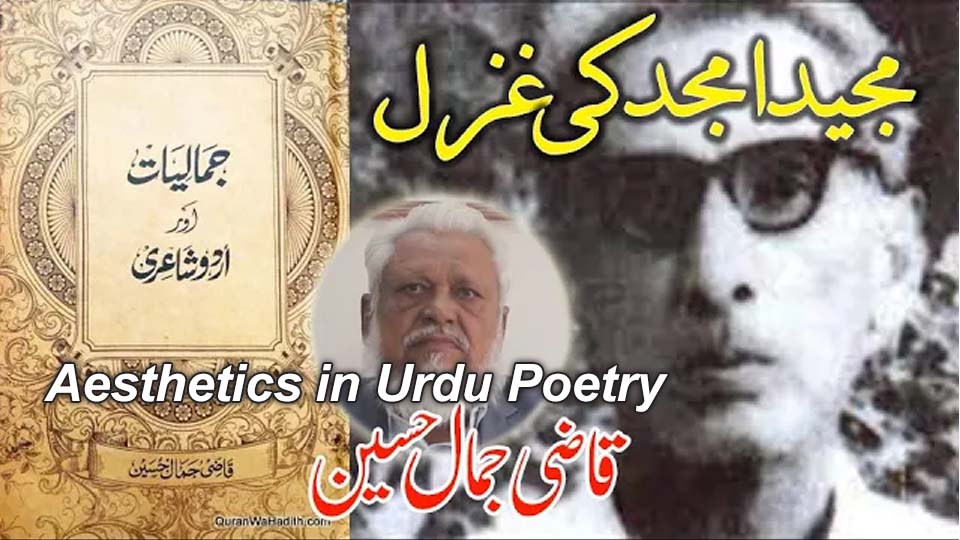Aesthetics in Urdu Poetry is not just about the arrangement of beautiful words—it’s a universe where thought meets expression, and emotion merges with structure. The essence of this art lies in its delicate beauty and the often-overlooked hidden tensions that breathe life into poetic expression.
The Hidden Layers of Poetic Beauty
What makes aesthetics in Urdu poetry truly remarkable is its multi-layered nature. At first glance, a ghazal may appear to be an emotional outburst of love or grief. Still, a deeper reading reveals structured harmony, rhythmic balance, and philosophical undertones. This fusion of form and feeling is not accidental—it reflects a deep engagement with philosophical aesthetics, which underpins much of classical and modern Urdu poetry.
Poets like Majid Amjad, whose work has been critically examined by Qazi Jamal Hussain, embody this union of form and substance. Their poetry does not shout—it whispers, it flows, and it lingers. The aesthetic tension is subtle, yet powerful.
Qazi Jamal Hussain and the Philosophy of Aesthetics
In his landmark book “Jamaliyat aur Urdu Shayari“ (Aesthetics and Urdu Poetry), Qazi Jamal Hussain fills a long-standing gap in Urdu literary criticism. Unlike surface-level commentary that merely praises emotional depth, Hussain explores the philosophical core of poetic beauty. He connects Urdu literary tradition with international theories of aesthetics, giving readers a broader, more critical lens to view poetic works.
In his essay on Majid Amjad, Hussain presents a detailed, nuanced evaluation of poetic elements like diction, tone, and rhythm, revealing the hidden tensions that lie beneath the seemingly serene surface.
Majid Amjad: The Poet of Silence and Subtlety
Majid Amjad’s poetry is an exemplary model of aesthetics in Urdu poetry. His verses neither rebel against tradition nor surrender to it blindly. Instead, they reinterpret it, offering a fresh perspective that is deeply rooted in literary introspection. His ghazals are marked by restraint—avoiding emotional excess, and favoring philosophical calm.
According to Qazi Jamal Hussain, Amjad’s poetic voice is not loud but consistent, thoughtful, and quietly revolutionary. The aesthetic experience in his poetry arises from a tension between serenity and meaning—what you see is just one layer; what you feel runs much deeper.
Why Aesthetic Criticism Matters in Urdu Literature
Despite the richness of aesthetics in Urdu poetry, the tradition of aesthetic literary criticism has remained relatively underexplored. Most critical works tend to focus on political, romantic, or symbolic themes while neglecting the form, structure, and artistic balance that make poetry last beyond its time.
Hussain’s contribution lies in offering a framework to analyze the beauty and complexity of poetic works without reducing them to mere emotion. His writing reflects a powerful blend of intellectual clarity and poetic empathy, allowing readers to experience poetry as both art and insight.
Delicate Beauty and Hidden Tensions: The Reader’s Experience
The real strength of aesthetics in Urdu poetry lies in how it connects with the reader—not through grand declarations, but through delicate emotional shifts and understated elegance. The hidden tensions that lie in a poet’s subtle irony, in the pause between verses, or in the duality of a metaphor, are what make the experience deeply personal and lasting.
When poetry is viewed through this aesthetic lens, its emotional depth, structural integrity, and artistic craft become more visible and more valuable. It transforms from mere literary consumption to an immersive, almost meditative experience.
Conclusion: Toward a Deeper Appreciation
Aesthetics in Urdu poetry is more than an academic concept—it is a necessary tool for appreciating the true soul of poetic expression. Thanks to scholars like Qazi Jamal Hussain and poets like Majid Amjad, we are now better equipped to explore the delicate beauty and hidden tensions that define this timeless art form.
For readers, writers, and critics alike, aesthetic criticism is not a luxury—it is essential. It teaches us to slow down, to read between the lines, and to see poetry not just as emotion, but as architecture, as philosophy, as life itself.
If you’re interested in reading this book, click the link below for a free download.
https://drive.google.com/file/d/1rg0mYzY4EnT0k1j3r5kBc7Mh41kF4585/view?usp=sharing
If you’d like to listen to this book in audio format, click the CONTACT button below to get in touch with the AwazeUrdu team to order the audiobook.
You can also watch the same video on these social media platforms.
اردو شاعری محض الفاظ کی سجاوٹ نہیں، بلکہ حسنِ خیال، طرزِ احساس اور فنکارانہ اظہار کی جمالیاتی دنیا ہے۔ اس میں صرف جذبے نہیں، بلکہ جمالی ترتیب، توازن اور تہہ داری بھی شامل ہوتی ہے، جسے سمجھنے کے لیے تنقیدی بصیرت کی ضرورت ہے۔ جمالیات، یعنی فلسفۂ حسن، ادب کا وہ پہلو ہے جو فن پارے کے حسن اور اس کے معنوی گہرائی کو جانچنے کا زاویہ فراہم کرتا ہے۔ اردو تنقید میں اس موضوع پر نسبتاً کم کام ہوا ہے، لیکن قاضی جمال حسین نے اپنی کتاب
“جمالیات اور اردو شاعری”
میں اس خلا کو بخوبی پورا کیا ہے۔ ان کا تحریر کردہ مضمون “مجید امجد کی غزل” اسی کتاب کا ایک باب ہے، جس کا اقتباس آوازِ اردو کی محفلِ سخن میں پیش کیا گیا، جس نے اردو شاعری کی جمالیاتی پرتوں کو نئے انداز سے سمجھنے میں مدد دی۔
قاضی جمال حسین اردو ادب کے ایک سنجیدہ نقاد، محقق اور ماہرِ جمالیات ہیں جنہوں نے اردو شاعری میں جمالیاتی تنقید کو ایک باضابطہ علمی اور فکری جہت دی۔ انہوں نے ادب کو محض جذباتی اظہار کے بجائے فلسفیانہ تجزیے کے دائرے میں داخل کیا۔ ان کی تحریروں میں زبان کی سادگی اور فکری گہرائی کا حسین امتزاج نظر آتا ہے۔ انہوں نے اردو تنقید کو بین الاقوامی فلسفۂ جمالیات سے مربوط کر کے اردو قاری کے لیے ایک نیا علمی دریچہ کھولا۔ ان کی نمایاں کتاب
“جمالیات اور اردو شاعری”
اردو شاعری میں حسنِ فن، طرزِ اظہار اور تخلیقی انفرادیت کو نئے تنقیدی زاویے سے دیکھنے کی ایک اہم کوشش ہے۔
جمالیات اور اردو شاعری ایک تحقیقی کتاب ہے جس میں فلسفۂ حسن کو اردو شاعری کے پس منظر میں نہایت باریکی سے بیان کیا گیا ہے۔ قاضی جمال حسین نے اختر شیرانی، مجاز، جذبی، سردار جعفری اور مجید امجد جیسے شعرا کے کلام کو جمالیاتی اصولوں کی روشنی میں پرکھا ہے۔ یہ کتاب صرف نظری مباحث تک محدود نہیں، بلکہ اس میں عملی تجزیات بھی شامل ہیں، جو قاری کو شاعری کے اندرونی حسن، اس کی ساخت، آواز، تاثر اور معنوی پرتوں تک رسائی فراہم کرتے ہیں۔ یہی وہ زاویہ ہے جو اردو تنقید میں قاضی صاحب کی علمی پہچان بناتا ہے۔
کتاب کے جس باب سے آوازِ اردو نے اقتباس سنایا، وہ مجید امجد کی شاعری پر مبنی ہے، جس میں شاعر کے طرزِ احساس، انفرادیت، طرزِ اظہار، اور روایت سے ان کے تعلق کو نہایت نفاست سے بیان کیا گیا ہے۔ قاضی صاحب کے مطابق مجید امجد کی آواز اپنی انفرادیت کے باعث روایتی شعری لہجوں سے الگ ہے، لیکن ان کا یہ نیا پن روایت سے مکمل انحراف نہیں، بلکہ روایت سے ہم آہنگ ہو کر اس سے نیا مفہوم اخذ کرنے کی شعوری کوشش ہے۔ مجید امجد کی شاعری میں سکون، آہستگی، توازن، اور جذباتی شدت سے گریز، ایک ایسی فضا پیدا کرتا ہے جو قاری پر رفتہ رفتہ اثر انداز ہوتی ہے۔ ان کے اشعار میں لفظیات، ساخت، اور معنی سب کچھ اس حسنِ اعتدال کا اظہار کرتے ہیں۔ اس مضمون میں قاضی صاحب نے جس باریکی سے اشعار کے نحوی اور معنوی پہلوؤں کی وضاحت کی ہے، وہ نہ صرف شاعر کے اسلوب کو واضح کرتا ہے، بلکہ جمالیاتی تنقید کا عملی مظاہرہ بھی بن جاتا ہے۔
مجید امجد کے یہاں ایک پیچیدہ صورتِ حال کو جذب کرنے اور اسے شاعری میں سادہ مگر گہری صورت میں ڈھالنے کی فنکارانہ صلاحیت موجود ہے۔ ان کے اشعار نہ کسی ایک جذباتی کیفیت کے ترجمان ہیں اور نہ ہی محض روایت کی تکرار، بلکہ وہ کیفیت، جذبہ، تاثر اور فکر کے امتزاج سے قاری کے لیے ایک خاموش مگر گہرے تجربے کا سامان فراہم کرتے ہیں۔ قاضی جمال حسین نے اس اقتباس میں جس تفصیل سے ان پہلوؤں کو واضح کیا، وہ نہ صرف مجید امجد کے فنی شعور کی گواہی ہے بلکہ قاضی صاحب کی تنقیدی گہرائی کا بھی مظہر ہے۔
اس کتاب اور آوازِ اردو کے ذریعے پیش کیے گئے اس اقتباس سے یہ اندازہ ہوتا ہے کہ اردو شاعری کو محض جذباتی اظہار نہیں بلکہ جمالیاتی ترتیب، فکری توازن، اور معنوی تہہ داری کے آئینے میں دیکھنا کس قدر ضروری اور بصیرت افروز ہے۔ قاضی جمال حسین نے جس علمی گہرائی سے اردو شاعری کی جمالیات کو پرکھا ہے، وہ ادب کے سنجیدہ قارئین کے لیے نہایت اہم ہے اور یہی ان کی کتاب کو اردو تنقید میں ایک نمایاں مقام عطا کرتا ہے۔

